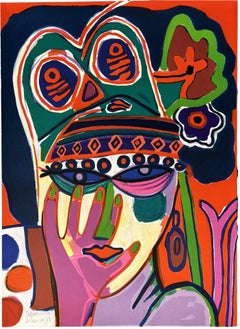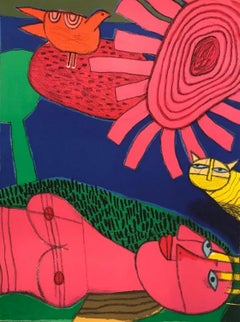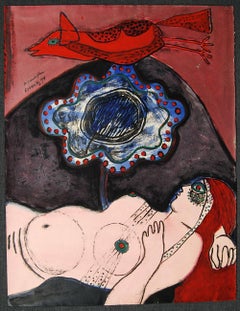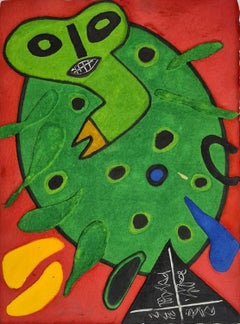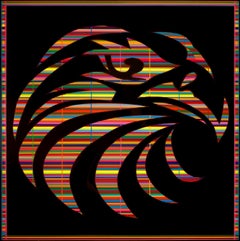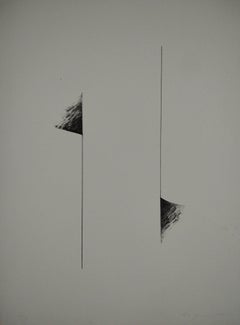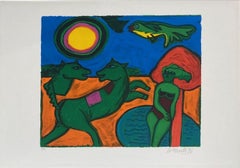Guillaume Corneille Art
Dutch, 1922-2010
Corneille, also known as Corneille Guillaume Beverloo, was a painter and graphic artist who radicalized the conservative Dutch art world in the early 1950s. He founded CoBrA in 1949, a post-war Expressionist European movement, along with five other influential artists that included Karel Appel and Constant. Born to Dutch parents in Liege, Belgium on July 3, 1922, Corneille went on to study art at the Academy of Art in Amsterdam in 1940, but is generally considered a self-trained painter. His approach is often described as imaginative and poetic, and is characterized by an eccentric use of color and his placing of familiar subjects, such as cats, birds, and women, in mythological or juvenile settings. “I am a painter of joy,” the artist declared at his 2007 exhibit at the Cobra Museum. He was notably influenced by African art, which he collected during his time traveling throughout the continent during the 1950s. His work was also affected by Pablo Picasso and Paul Klee, and, most notably, Vincent van Gogh’s use of color and form. His works are featured in collections at the Cobra Museum of Modern Art in the Netherlands, the Fine Arts Museums of San Francisco, and the Museum of Fine Arts in Boston. He died on September 5, 2010 in Paris, France.(Biography provided by Galerie Sommerlath)
to
1
7
2
9
7
4
2
1
1
1
Portrait 1982 Signed Limited Edition Lithograph
By Guillaume Corneille
Located in Rochester Hills, MI
Guillaume Corneille
Portrait - 1982
Print - Lithograph on Arches Archival Paper 30'' x 22''
Edition: signed in pencil and marked 25/300
As a co-founder of the famed experimental art...
Category
1980s Abstract Expressionist Guillaume Corneille Art
Materials
Lithograph
Blue cat
By Guillaume Corneille
Located in Paris, FR
Lithograph, 1996
Handsigned by the artist in pencil and numbered 137/200
42.00 cm. x 60.00 cm. 16.54 in. x 23.62 in. (paper)
32.00 cm. x 40.00 cm. 12.6 in. x 15.75 in. (image)
LCD4872
Category
1990s Abstract Guillaume Corneille Art
Materials
Lithograph
Young lady and a bird
By Guillaume Corneille
Located in Paris, FR
Lithograph, 1994
Handsigned by the artist in pencil and numbered 36/200
65.50 cm. x 50.00 cm. 25.79 in. x 19.69 in. (paper)
65.50 cm. x 50.00 cm. 25.79 in. x 19.69 in. (image)
LCD5576
Category
1990s Abstract Guillaume Corneille Art
Materials
Lithograph
Tribu
By Guillaume Corneille
Located in Paris, FR
Lithograph, 1992
Handsigned by the artist in pencil and numbered XXXVIII/L
75.50 cm. x 86.50 cm. 29.72 in. x 34.06 in. (paper)
50.00 cm. x 61.00 cm. 19.69 in. x 24.02 in. (image)
...
Category
1990s Abstract Guillaume Corneille Art
Materials
Lithograph
“Le Gran Fleur”, 1974
By Guillaume Corneille
Located in Rochester Hills, MI
Guillaume Corneille
“Le Gran Fleur”, 1974
Painting Gouache and Acrylic Paint on paper
25.5 x 19.5 in
66 x 50 cm
signed and dated in image
CONDITION NOTE: Push pin holes in all 4 cor...
Category
1970s Guillaume Corneille Art
Materials
Gouache
No title
By Guillaume Corneille
Located in Paris, FR
Engraving, 1997
Handsigned by the artist in pencil and numbered 6/60
LCD5427
Category
1990s Abstract Guillaume Corneille Art
Materials
Engraving
Piège - Lithograph by Guillaume Corneille - 1975
By Guillaume Corneille
Located in Roma, IT
Piège is an original contemporary artwork realized by Guillaume Corneille in 1975.
Original Lithograph on vélin paper
Hand signed and dated in pencil on the lower margin.
Numbere...
Category
1970s Contemporary Guillaume Corneille Art
Materials
Lithograph
Piège - Lithograph by Guillaume Corneille - 1956
By Guillaume Corneille
Located in Roma, IT
Piège is an original contemporary artwork realized by Guillaume Corneille in 1956.
Original Lithograph on vélin paper
Hand signed and dated in pencil on the lower margin.
Guillau...
Category
1950s Contemporary Guillaume Corneille Art
Materials
Lithograph
Blauer Stern
By Guillaume Corneille
Located in Tbilisi, GE
Comes with gallery invoice and certificate
Category
20th Century Contemporary Guillaume Corneille Art
Materials
Lithograph
Related Items
America (Limited Edition Print)
By Mauro Oliveira
Located in LOS ANGELES, CA
**ANNUAL SUPER SALE UNTIL MAY 15TH ONLY**
THIS PRICE WON'T BE REPEATED AGAIN THIS YEAR - TAKE ADVANTAGE OF IT**
"America" is a unique eagle design by Mauro Oliveira.
This exquisite...
Category
21st Century and Contemporary Abstract Expressionist Guillaume Corneille Art
Materials
Cotton Canvas
Untitled
Located in Barcelona, ES
The painting is being offered with a work and authenticity certificate
Category
1970s Abstract Guillaume Corneille Art
Materials
Engraving
Woman Circus Rider on Red Horse - superb Chagall poster
By Marc Chagall
Located in London, GB
Original lithographic poster printed by L.R.B Permild and Rosengreen.
Category
Late 20th Century Abstract Guillaume Corneille Art
Materials
Lithograph
The Abduction of the Sabine Women , a Renaissance drawing by Biagio Pupini
Located in PARIS, FR
This vigorous drawing has long been attributed to Polidoro da Caravaggio: The Abduction of the Sabine Women is one of the scenes that Polidoro depicted between 1525 and 1527 on the façade of the Milesi Palazzo in Rome. However, the proximity to another drawing inspired by this same façade, kept at the Ecole des Beaux-Arts, and to other drawings inspired by Polidoro kept at the Musée du Louvre, leads us to propose an attribution to Biagio Pupini, a Bolognese artist whose life remains barely known, despite the abundant number of drawings attributed to him.
1. Biagio Pupini, a Bolognese artist in the light of the Roman Renaissance
The early life of Biagio Pupini, an important figure of the first half of the Cinquecento in Bologna - Vasari mentions him several times - is still poorly known. Neither his date of birth (probably around 1490-1495) nor his training are known. He is said to have been a pupil of Francesco Francia (1450 - 1517) and his name appears for the first time in 1511 in a contract with the painter Bagnacavallo (c. 1484 - 1542) for the frescoes of a church in Faenza. He then collaborated with Girolamo da Carpi, at San Michele in Bosco and at the villa of Belriguardo.
He must have gone to Rome for the first time with Bagnacavallo between 1511 and 1519. There he discovered the art of Raphael, with whom he might have worked, and that of Polidoro da Caravaggio. This first visit, and those that followed, were the occasion for an intense study of ancient and modern art, as illustrated by his abundant graphic production.
Polidoro da Caravaggio had a particular influence on the technique adopted by Pupini. Executed on coloured paper, his drawings generally combine pen, brown ink and wash with abundant highlights of white gouache, as in the drawing presented here.
2. The Abduction of the Sabine Women
Our drawing is an adaptation of a fresco painted between 1525 and 1527 by Polidoro da Caravaggio on the façade of the Milesi Palace in Rome. These painted façades were very famous from the moment they were painted and inspired many artists during their stay in Rome. These frescoes are now very deteriorated and difficult to see, as the palace is in a rather narrow street.
The episode of the abduction of the Sabine women (which appears in the centre of the photo above) is a historical theme that goes back to the origins of Rome and is recounted both by Titus Livius (Ab Urbe condita I,13), by Ovid (Fasti III, 199-228) and by Plutarch (II, Romulus 14-19). After killing his twin brother Romus, Romulus populates the city of Rome by opening it up to refugees and brigands and finds himself with an excess of men. Because of their reputation, none of the inhabitants of the neighbouring cities want to give them their daughters in marriage. The Romans then decide to invite their Sabine neighbours to a great feast during which they slaughter the Sabines and kidnap their daughters.
The engraving made by Giovanni Battista Gallestruzzi (1618 - 1677) around 1656-1658 gives us a good understanding of the Polidoro fresco, allowing us to see how Biagio Pupini reworked the scene to extract this dynamic group.
With a remarkable economy of means, Biagio Pupini takes over the left-hand side of the fresco and depicts in a very dense space two main groups, each consisting of a Roman and a Sabine, completed by a group of three soldiers in the background (which seems to differ quite significantly from Polidoro's composition).
The balance of the drawing is based on a very strongly structured composition. The drawing is organised around a median vertical axis, which runs along both the elbow of the kidnapped Sabine on the left and the foot of her captor, and the two main diagonals, reinforced by four secondary diagonals. This diamond-shaped structure creates an extremely dynamic space, in which centripetal movements (the legs of the Sabine on the right, the arm of the soldier on the back at the top right) and centrifugal movements (the arm of the kidnapper on the left and the legs of the Sabine he is carrying away, the arm of the Sabine on the right) oppose each other, giving the drawing the appearance of a whirlpool around a central point of support situated slightly to the left of the navel of the kidnapper on the right.
3. Polidoro da Caravaggio, and the decorations of Roman palaces
Polidoro da Caravaggio was a paradoxical artist who entered Raphael's (1483 - 1520) workshop at a very young age, when he oversaw the Lodges in the Vatican. Most of his Roman work, which was the peak of his career, has disappeared, as he specialised in facade painting, and yet these paintings, which are eminently visible in urban spaces, have influenced generations of artists who copied them abundantly during their visits to Rome.
Polidoro Caldara was born in Caravaggio around 1495-1500 (the birthplace of Michelangelo Merisi, known as Caravaggio, who was born there in 1571), some forty kilometres east of Milan. According to Vasari, he arrived as a mason on the Vatican's construction site and joined Raphael's workshop around 1517 (at the age of eighteen according to Vasari). This integration would have allowed Polidoro to work not only on the frescoes of the Lodges, but also on some of the frescoes of the Chambers, as well as on the flat of Cardinal Bibiena in the Vatican.
After Raphael's death in 1520, Polidoro worked first with Perin del Vaga before joining forces with Maturino of Florence (1490 - 1528), whom he had also known in Raphael's workshop. Together they specialised in the painting of palace façades. They were to produce some forty façades decorated with grisaille paintings imitating antique bas-reliefs.
The Sack of Rome in 1527, during which his friend Maturino was killed, led Polidoro to flee first to Naples (where he had already stayed in 1523), then to Messina. It was while he was preparing his return to the peninsula that he was murdered by one of his assistants, Tonno Calabrese, in 1543.
In his Vite, Vasari celebrated Polidoro as the greatest façade decorator of his time, noting that "there is no flat, palace, garden or villa in Rome that does not contain a work by Polidoro". Polidoro's facade decorations, most of which have disappeared as they were displayed in the open air, constitute the most important lost chapter of Roman art of the Cinquecento. The few surviving drawings of the painter can, however, give an idea of the original appearance of his murals and show that he was an artist of remarkable and highly original genius.
4. The façade of the Milesi Palace
Giovanni Antonio Milesi, who commissioned this palace, located not far from the Tiber, north of Piazza Navona, was a native of the Bergamo area, like Polidoro, with whom he maintained close friendly ties. Executed in the last years before the Sack of Rome, around 1526-1527, the decoration of Palazzo Milesi is considered Polidoro's greatest decorative success.
An engraving by Ernesto Maccari made at the end of the nineteenth century allows us to understand the general balance of this façade, which was still well preserved at the time. The frescoes were not entirely monochrome, but alternated elements in chiaroscuro simulating marble bas-reliefs and those in ochre simulating bronze and gold vases...
Category
16th Century Old Masters Guillaume Corneille Art
Materials
Ink, Gouache, Pen
Exclusive invitation with first day cover Jackson Pollock Lee Krasner Foundation
By Jackson Pollock
Located in New York, NY
Jackson Pollock
Exclusive invitation with first day cover, 1999
Offset lithograph fold out invitation with postmarked first day cover
Stamp with official postmark from the US Post Of...
Category
1990s Abstract Expressionist Guillaume Corneille Art
Materials
Mixed Media, Offset
No Reserve
H 6.75 in W 7 in
Freya (Seated Backwards), Mixed media on grey board
By Howard Tangye
Located in London, GB
Howard Tangye (b.1948, Australia) has been an influential force in fashion for decades. Lecturing at London’s Central Saint Martins for 35 years, including 16 years as head of BA Wom...
Category
2010s Contemporary Guillaume Corneille Art
Materials
Other Medium, Archival Paper, Handmade Paper, Pen, Felt Pen, Permanent M...
Spiral
By Alexander Calder
Located in New York, NY
Alexander Calder
Spiral, 1970
Hand-signed
Lithograph
25.5 x 19.5
22/75
Category
1970s Abstract Guillaume Corneille Art
Materials
Lithograph
Cup 2 Picasso (Sparks 113; Field 168; ULAE 123), Jasper Johns
By Jasper Johns
Located in Fairfield, CT
Artist: Jasper Johns (1930)
Title: Cup 2 Picasso (Sparks 113; Field 168; ULAE 123)
Year: 1973
Medium: Color lithograph on wove paper
Edition: 1,500
Size: 14 x 10.5 inches
Inscription: Signed & dated with the artist's plate-signed signature.
Condition: Excellent
Notes: This image, as well as a companion print Cups 4 Picasso, is based on Marcel Duchamp’s 1958 collage Self-Portrait in Profile. Printed by Bill Goldston and James V...
Category
1970s Abstract Expressionist Guillaume Corneille Art
Materials
Lithograph
Untitled from the portfolio “Poems dans le ciel”
By Sam Francis
Located in Ljubljana, SI
Poems dans le ciel (eng. Poems in the sky). Original lithograph, 1986. Edition of 100 signed and numbered impressions on Arches paper.
Samuel Lewis Francis was an American artist, we...
Category
1980s Abstract Guillaume Corneille Art
Materials
Lithograph
Limited Edition 2011 Marielle Guégan French Artist Gravure/Engraving
By Guégan Marielle
Located in Paris, FR
The sixth of 20 of this limited edition Marielle Guégan engraving created in 2011.
Marielle Guégan is a French painter and engraver. During her studies as an interior designer, she...
Category
21st Century and Contemporary Abstract Guillaume Corneille Art
Materials
Engraving, Paper
H 15.16 in W 11.03 in D 0.04 in
untitled
By Richard Hunt
Located in New York, NY
Lithograph printed in black and grey in an edition of 43
Category
2010s Abstract Guillaume Corneille Art
Materials
Lithograph
Composition from the series "Von Kopf bis Fuss" (1967) litograph in color 10/75
By Asger Jorn
Located in Milano, MI
ASGER JORN
(Jutland 1914-1973 Aarhus)
From head to toe. 1966/67.
lithograph numbered 10/75, signed lower right: Jorn. Paper size 90 x 63 cm
Published and printed by Erker-Presse, ...
Category
1960s Abstract Guillaume Corneille Art
Materials
Lithograph
H 35.44 in W 25.2 in D 0.04 in
Previously Available Items
The Green Lady
By Guillaume Corneille
Located in Paris, FR
Lithograph, 1996
Handsigned by the artist in pencil and annotated EA
Artist proof
Edition : 200
42.00 cm. x 60.00 cm. 16.54 in. x 23.62 in. (paper)
33.00 cm. x 40.00 cm. 12.99 in. ...
Category
1990s Abstract Guillaume Corneille Art
Materials
Lithograph
Guillaume Corneille art for sale on 1stDibs.
Find a wide variety of authentic Guillaume Corneille art available for sale on 1stDibs. If you’re browsing the collection of art to introduce a pop of color in a neutral corner of your living room or bedroom, you can find work that includes elements of green, red and other colors. You can also browse by medium to find art by Guillaume Corneille in lithograph, paint, watercolor and more. Much of the original work by this artist or collective was created during the 20th century and is mostly associated with the abstract style. Not every interior allows for large Guillaume Corneille art, so small editions measuring 1 inch across are available. Customers who are interested in this artist might also find the work of Paul Maxwell, Fausto Melotti, and Pat Steir. Guillaume Corneille art prices can differ depending upon medium, time period and other attributes. On 1stDibs, the price for these items starts at $499 and tops out at $15,000, while the average work can sell for $1,087.
